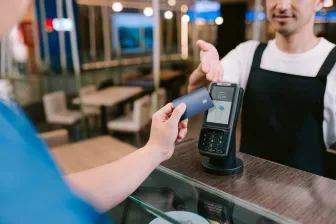There has been a tremendous amount of conversation recently around biometrics and its role in payments. The idea that we can pay for goods and services without having to carry a wallet or even a phone is certainly appealing, but what’s the current state of play? And where are we headed?
What Are Biometrics? What Are the Types Used in Payments?
Let’s start with a definition. Biometrics covers the measurement of any aspect of our physical human characteristics – from the unique shape of our face or fingers to our DNA. Fingerprint scanning has been in existence for a long time and is one of the most popular biometric data points used for authentication: from immigration at an airport to unlocking your phones.
When it comes to payments, many methods that read biometric data are reliable, but not all are easy to manage or socially comfortable for consumers to use. Over the years, the payment industry seems more focused on two main approaches: Fingerprint analysis and Face/eye recognition. Both approaches are based on what today’s consumers are already comfortable with. Most high-end laptop computers are equipped with fingerprint scanners for better security. And if you look at the latest smartphones, they too have similar technology to use fingerprint or face scanning for security purposes.
How Do Biometric Payments Work?
Biometrics are used in payments mainly for authentication purposes. Data such as fingerprints, face/eye scans can help verify the identity of the person paying. It all works in two main ways:
- The first is by customer authenticating their identity on their device (for example, approving a transaction on a smartphone using the inbuilt fingerprint reader or face ID). This method is most common nowadays with mobile wallets that use fingerprint scanning or face ID to help customers pay with contactless technology such as Apple Pay and Google Pay.
- The second uses in-store hardware to capture the image, typically a high-definition camera and a large screen or a modified payment terminal that can capture this information. Though uncommon in North America, this in-store hardware can not only be useful for payment acceptance but may have other applications in the future, such as identity and age verification.
Phone-Based Biometrics Are Simplest and Most Popular
In almost all markets, the preferred model is using the phone for authentication. This is driven primarily by consumer confidence in the technology. A typical consumer is happy to have their biometric information stored on a device that they own – as it seems they have more control over it compared to an external device. The secondary driver is cost. If the smartphone is handling the biometric identification, then, once approved, the transaction can flow to a standard POS terminal via NFC as a standard contactless card or mobile wallet transaction. For merchants, this means that they don’t need to make any changes to their POS system or get any complex development work done for the payment service provider.
Non-Phone Based Biometrics are Complex
As you move away from smartphones to non-phone-based biometric payments, the level of complexity increases for merchants. There is a lack of standards which makes the rollout of this technology internationally very difficult for manufacturers and implementation costs can be high, so merchants can be deterred from considering this option altogether. For now, non-phone-based biometrics create more challenges for merchants who wish to adopt this technology. I will discuss these challenges in a future blog post.
What Does This Mean for The Future of Biometric Payments?
In North America, biometric authentication is real and already happening, but mainly on smartphones. In this case, there is very little impact on a merchant or a technology provider. The smartphone may be running powerful and complex analytics in the background, but for the merchant, they simply see a contactless transaction, one that may be at a higher transaction value than they might normally be able to approve.
If you are looking to learn more about biometric payments and understand what is the best solution for your business get in touch with us.
Ian Benn is the Head of Strategy and Market Development at Ingenico











